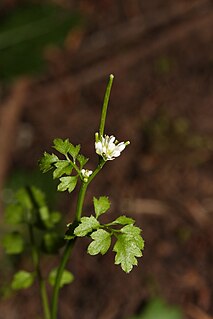
Cardamine is a large genus of flowering plants in the mustard family, Brassicaceae, known as bittercresses and toothworts. It contains more than 200 species of annuals and perennials. Species in this genus can be found worldwide, except the Antarctic, in diverse habitats. The name Cardamine is derived from the Greek kardaminē, water cress, from kardamon, pepper grass.

Draba is a large genus of flowering plants in the family Brassicaceae, commonly known as whitlow-grasses.
Francis Whittier Pennell was an American botanist best known for his studies of the Scrophulariaceae. Employed by the New York Botanical Garden and then by the Academy of Natural Sciences of Philadelphia, he carried out botanical research in both North America and South America.
Mortoniella is a monotypic genus of flowering plants in the family Apocynaceae, first described as a genus in 1939. It contains only one known species, Mortoniella pittieri, native to Central America.
Weberbauera is a genus of flowering plants in the crucifer family Brassicaceae, native to the central Andes; Peru, Chile, Bolivia, and Argentina.
Chilocardamum is a small genus of four herbaceous cress-like species of plants in the family Brassicaceae, only found growing in Patagonia, southern Argentina.

Polypsecadium is a genus of large herbaceous species of plants in the family Brassicaceae, found growing in South America. Most of the species were formerly classified in the genus Sisymbrium.
Chaunanthus is a genus of flowering plants belonging to the family Brassicaceae.
Ivania is a genus of flowering plants belonging to the family Brassicaceae.
Ianhedgea is a monotypic genus of flowering plants belonging to the family Brassicaceae. It only contains one species, Ianhedgea minutiflora(Hook.f. & Thomson) Al-Shehbaz & O'Kane
Mancoa is a genus of flowering plants belonging to the family Brassicaceae.
Exhalimolobos is a genus of flowering plants belonging to the family Brassicaceae.
Menonvillea is a genus of flowering plants belonging to the family Brassicaceae.
Dielsiocharis is a genus of flowering plants belonging to the family Brassicaceae.
Dryopetalon is a genus of flowering plants belonging to the family Brassicaceae.
Hemilophia is a genus of flowering plants belonging to the family Brassicaceae.
Neuontobotrys is a genus of flowering plants belonging to the family Brassicaceae.
Romanschulzia is a genus of flowering plants belonging to the family Brassicaceae.
Parlatoria is a monotypic genus of flowering plants belonging to the family Brassicaceae. It just contains one species, Parlatoria cakiloideaBoiss.



